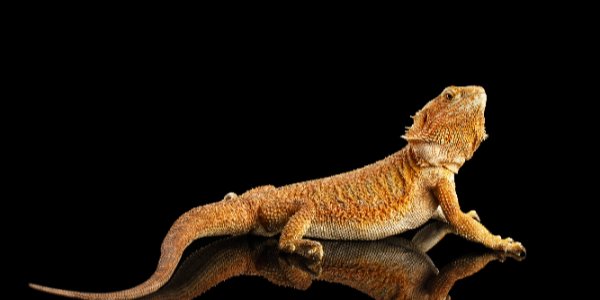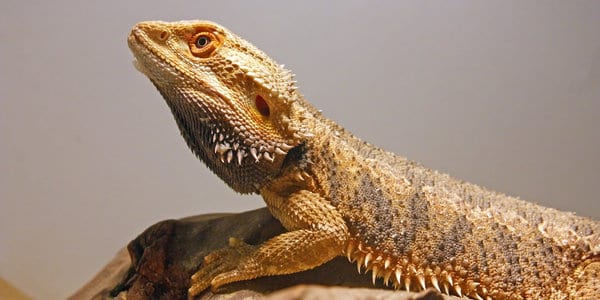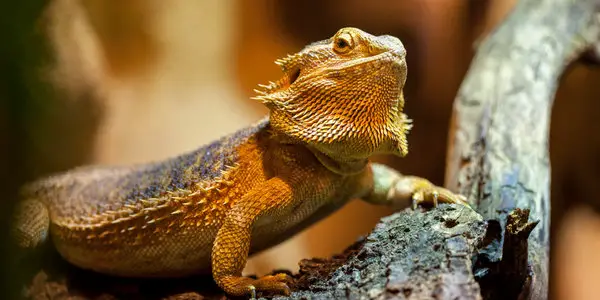Bearded dragons shed every week or two as long as they’re hatchlings (up to six months old). Afterward, the shedding frequency drops to once every two months. When a bearded dragon becomes an adult (18+ months), it will start shedding even less frequently, once or twice a year.
Like all reptiles, bearded dragons follow a semi-regular shedding schedule throughout their lifetime.
While continuous, a bearded dragons shedding habits aren’t entirely regular, as the process’ frequency and timeframe change significantly as the bearded dragon ages.
Therefore, if you notice your bearded dragon skin getting flaky or dull, you don’t need to panic; chances are your pet is going through the fascinating yet natural bearded dragon shedding process (ecdysis).
Bearded dragon shedding process is a healthy, natural process for bearded dragons. In the following sections, I’ll take you through everything you need to know about your bearded dragon shedding habits.
Whether you’re curious to find out how long the process lasts or whether it will affect your pet’s temperament, keep reading.
Do Bearded Dragons Shed?
Bearded dragons shed just like all other reptiles. The phenomenon starts when old skin flakes off to make room for a new layer growing underneath. Bearded dragons shed either due to growth or to replace damaged skin. Shedding process frequency declines as a bearded dragon grows older.
Even though it has already been established, it’s worth repeating: don’t panic if you see your bearded dragon skin flaking off (as long as the process roughly follows the frequency mentioned above).
All bearded dragons shed, albeit some do so more than others.
Generally speaking, there are two main reasons why bearded dragons shed:
- They’re growing.
- They’re trying to replace damaged skin cells.
Growth-Related Shedding
Growth is arguably the leading cause of shedding, which is why hatchlings go through the process much more frequently than adult bearded dragon (more on this in a moment).
Therefore, instead of worrying upon seeing your baby bearded dragon change its “coat,” take it as a good sign that your pet bearded dragons is healthy and growing bigger.
The reason why growth triggers shedding in bearded dragons is that, unlike human skin, theirs is neither porous nor elastic.
Therefore, as soon as their measurements change, a new layer of skin should be formed to accommodate the increased body surface.
During that first year, when growth is most exponential, the shedding will be much more frequent.
Skin Damage-Related Shedding
When the growth process is over, bearded dragons cut their shedding schedule back to once or twice a year(only to replace any damaged skin).
Bearded dragons are active animals and can often put their body through a lot of stress, and their skin is bound to get dirty, scratched, or even cut.
Luckily, through shedding, your pet will be able to grow a new protective layer underneath to repair the damage in no time.
Regardless of whether the shedding is growth or damage-related, your job as a bearded dragon keepers is to support your pet as best as you can all the way through this sometimes uncomfortable process.

How Often Do Baby Bearded Dragons Shed?
Baby bearded dragons (0-6 months old) usually shed every week or every other week; however, the frequency can vary from one animal to another. Hatchlings go through a rapid growth process, and because their skins aren’t elastic, they need to grow a new layer to accommodate their development.
Therefore, you can expect your baby bearded dragon shedding to be a weekly occurrence, at least for the first few months.
Keep in mind that the phenomenon isn’t always uniform and can look different from one animal to another.
Shedding doesn’t always occur all over a bearded dragon’s body, especially when still in the hatchling phase.
Therefore, don’t panic if you find specific spots of flaky skin; it’s completely normal. In fact, the only instance in which you should be worried is if your baby bearded dragons doesn’t shed enough during the first few months.
As mentioned, shedding schedules can look very different even across the same species. So, for example, if your bearded dragon shed once every two and a half weeks instead of the usual one and a half, there’s likely no cause for worry.
However, if your pet seems to be shedding not nearly enough, it might be time to consult your veterinarian.
It’s essential to remember that the phenomenon serves as a sign that your hatchling is developing and growing normally.
What Do You Do When Your Bearded Dragon Is Shedding?
Even though shedding skin is a normal occurrence, it can still be an uncomfortable experience for your pet, especially for hatchlings who have to go through it so often.
Therefore, it’s your job as a bearded dragon owner to ensure that the process goes as smoothly as possible every time it occurs. Luckily, there are quite a few measures you can take to facilitate the phenomenon.
When your bearded dragon is shedding, the most important thing to do is to leave it alone and avoid handling it. Moreover, it helps to create a setup of rocks, branches, and substrates inside its enclosure to allow the animal to loosen any flaky skin if necessary. Provide enough heat and light.
Even though you won’t be able to actively make the process easier on your pet, as you can see, there are several approaches you can take to make the overall experience easier to endure.
For example, creating the right setup of durable (but not too scratchy) structures and materials inside your bearded dragon enclosure will help it loosen and remove any flaky old skin that just refuses to come off.
Furthermore, providing your pet with the ideal temperature and heat requirements is now more important than ever. Invest in a high-quality UVB light to ensure your bearded dragon is as comfortable as possible.
If you’re unsure how to create the ideal setup for a bearded dragon, I recommend reading through this Exotic Direct article.
If you want to spare a click, here’s a summary of what you can do while your bearded dragon is shedding:
- Invest in high-quality lighting and heating equipment to include in your bearded dragon’s enclosure.
- Increase the environment’s humidity or mist/ spray the beardie’s enclosure (or the beardie itself) to help keep its skin hydrated.
- Put rocks, branches, and other rough materials inside your bearded dragon’s enclosure.
- Maintain ideal environmental conditions and provide your pet with a balanced, nutritionally rich diet.
- Most importantly, never, EVER, try to pull or peel off your bearded dragon’s skin.
Can You Hold a Bearded Dragon While Shedding?
You can hold a bearded dragon while it’s shedding; however, try to keep contact at a bare minimum. Even though handling your shedding beardie for a short period won’t have any severe adverse effects, it’s still extremely uncomfortable for the animal. Therefore, only hold it if necessary.
As I mentioned several times throughout this article, shedding can be an uncomfortable experience, and as I’ll mention later on in one of the subsequent sections, some bearded dragons can be especially moody and temperamental throughout this process.
For this reason, it’s usually best to err on the side of safety and keep contact to a bare minimum.
Unless your pet is actively approaching and seeking comfort from you (which, while possible, doesn’t happen too often), only pick up a shedding bearded dragon when absolutely necessary. These instances include:
- Cleaning the tank
- Taking the bearded dragon out to exercise
- Bath time
- Emergencies
If the newly growing skin is still too delicate or overexposed, holding your bearded dragon (even though seemingly gently) can not only be uncomfortable but painful as well.
At the end of the day, you know your pet best; therefore, you’ll likely be able to understand their preferences and needs better and adjust your approach accordingly.
If you’re unsure on how to tell if you’re excessively handling your shedding bearded dragon, here are some signs that might indicate your pet is uncomfortable:
- Your beardie’s hiding/ not wanting to engage with you.
- Your beardie is showing signs of hostility or aggression.
- Shedding process is taking a lot longer than usual (the longer the process goes, the more irritable your beardie will become).

How Long Do Bearded Dragons Take To Shed?
Bearded dragons can take anywhere from a few days to three weeks to fully shed. Hatchlings (0-6 months) can usually go through a full-body shed within a 1-3 day range. Juvenile bearded dragon can take a week or two to shed all of their skin, while adult bearded dragons might require three full weeks (or even more).
As you might have noticed, the older a bearded dragon becomes, the longer it will take for it to fully shed.
However, since most beardies tend to flake off one portion at a time, the process can sometimes take even longer, depending on the circumstances, so take these time frames with a grain of salt.
On the other hand, if your pet hasn’t been able to replace its old skin within a month, it might be a good idea to consult with a vet, as after a while, the process will start becoming extremely uncomfortable (especially if it’s stuck).
Do Bearded Dragons Like To Be Touched When They Are Shedding?
No, Bearded dragons generally do not like to be touched when they are shedding. While there are some exceptions to this rule, it’s better to avoid handling a bearded dragon during this time, as contact can be not only uncomfortable but even painful in some instances.
Bearded dragons can get angry, grumpy, and even hostile when they’re shedding, especially if the process takes longer than expected.
Therefore (unless absolutely necessary), try not to touch your pet at all during this time, no matter how much you want to comfort them.
A beardie’s temperament can drastically change throughout the shedding process phenomenon, meaning even the most loving, peaceful creatures can resort to biting if they feel it’s necessary.
Do Bearded Dragons Get Grumpy When Shedding?
Bearded dragons can get grumpy when shedding. The process can be highly uncomfortable and, in some instances, even painful, which is why many bearded dragons will experience a negative shift in temperament when going through it. However, there are a few exceptions to this rule.
Even though it’s highly possible that your bearded dragon will become much more irritable when shedding, this isn’t a one-size-fits-all rule.
Some pets might even approach you themselves as they require additional contact time and support throughout this time.
However, if you do notice your bearded dragon starts getting grumpier as its shedding skin, remember this shift in behavior is completely normal, and your pet should revert to its loving, peaceful self as soon as the process is over.
Bearded dragon shedding behavior can be strange for bearded dragon owners but it will go away once its done.
Shedding process can be uncomfortable, itchy, and painful, which is why most beardies will start to withdraw and become more antisocial as their old skin flakes off.
Unfortunately, in this instance, there’s nothing you can do besides giving your pet the space and comfort it requires (and the ideal environment for it to feel as comfortable as possible).
Do Bearded Dragons Eat Their Shed?
Yes, bearded dragons eat their shed. This is a natural, instinctual response. Some bearded dragons might even lose appetite for their usual diet when shedding, as they’ll be consuming their shed skin.
Therefore, if you’ve noticed your bearded dragon eating its own skin, I’m here to assure you there’s nothing to worry about.
This behavior is a very useful evolutionary mechanism that has kept bearded dragons alive for so long.
There are three main reasons why bearded dragons eat their own shed in the wild:
- Food is scarce, and the animal needs to replenish the nutrients it’s losing just going through the process.
- Flaked-off skin tips off predators regarding a bearded dragon’s location, which is why the animal does its best to remove all traces.
- The bearded dragon is suffering from calcium deficiency.
However, you should still keep offering your bearded dragon its usual diet. It’s best to be sure that your pet is eating shed skin due to preference, not dire need.

Conclusion
Bearded dragon sheds regularly, like all other reptiles. As they age, the frequency and time frame of their shedding process will change.
However, it’s always crucial to ensure your pet is as comfortable as possible throughout this process, as, in some instances, bearded dragon shedding process can be painful, especially when prolonged.
Therefore, make sure to provide your bearded dragon with a comfortable enclosure and a nutritionally-rich diet, and try to keep touching and handling at a minimum.
Read more about the following:
